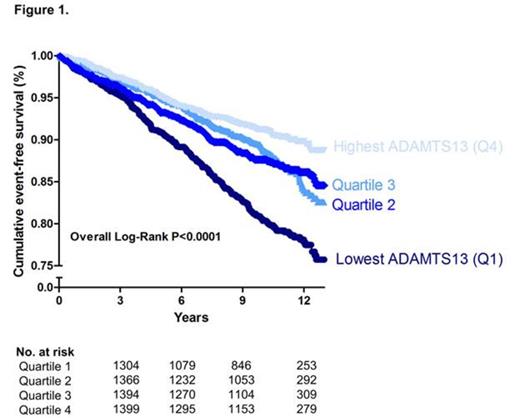Abstract
Introduction.ADAMTS13 has antithrombotic properties because it cleaves Von Willebrand factor (VWF) in smaller, less active multimers. Low ADAMTS13 activity may therefore increase the risk of arterial thrombosis, including ischemic stroke. We prospectively studied the association between ADAMTS13 activity, VWF antigen (VWF:Ag) levels and ischemic stroke in the Rotterdam Study, a population-based cohort study among subjects ≥ 55 years.
Methods.We included 5941 individuals without a history of stroke or TIA. Blood was drawn at baseline and ADAMTS13 activity (expressed as % of normal plasma) was measured using the FRETS-VWF73 assay and VWF:Ag levels by ELISA. All individuals were followed for development of stroke or TIA. The association between ADAMTS13 activity, VWF:Ag levels and ischemic stroke were assessed by Cox proportional hazard regression analysis.
Results.Over an average follow-up time of 9.5 years, 461 participants suffered from a stroke, 306 of which definitely classified as ischemic. After adjustment for cardiovascular risk factors, individuals with ADAMTS13 activity in the lowest quartile had a higher risk of ischemic stroke (HR 1.65, 95% CI 1.16 – 2.32) than those in the reference highest quartile. In individuals with low ADAMTS13 activity and high VWF:Ag levels the risk of ischemic stroke risk was 3.5 fold increased (HR 3.51, 95% CI 1.60 – 7.70).
Conclusions.In this large prospective population study, low ADAMTS13 activity predicts the risk of ischemic stroke, independently of age, sex, and established cardiovascular risk factors. This risk was even higher in individuals with both low ADAMTS13 activity and high VWF antigen levels.
Turecek:Baxter Innovations GmbH, Vienna, Austria: Employment. Rottensteiner:Baxter Innovations GmbH: Employment. Scheiflinger:Baxter Innovations GmbH: Employment. Leebeek:CSL Behring and Baxter: Membership on an entity's Board of Directors or advisory committees.
Author notes
Asterisk with author names denotes non-ASH members.


